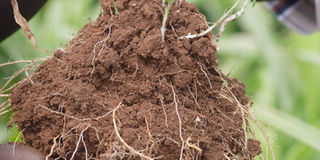Food supply threatened by invasive weed

PHOTO | TOM OTIENO Scientists show how the striga weed chokes maize plants at a Siaya farm on June 5, 2013. The weed, also known as witch weed, attacks maize, sorghum, millet and rice in Sub-Saharan Africa.
What you need to know:
- Striga can reduce maize yield by half if action is not taken urgently, says expert
Researchers have raised the alarm over weed that could reduce maize yield by half, threatening the country’s food supply.
They said the Striga weed had been detected in Rift Valley — the country’s food basket — and its effects could be devastating.
Dr Fred Kanampiu, an agronomist at the International Maize and Wheat Improvement Centre said the weed also spread fast and could destroy large swathes of land under maize.
Billions lost
“On average, a farmer could lose up to 60 per cent of the harvest depending on the level of infestation,” said Dr Kanampiu.
Farmers lose produce worth Sh4.5 billion per year due to weeds.
Dr Kanampiu warned that unless the government moved fast to tackle the problem, the country could be faced with a massive food shortage in the coming months.
“The Striga seeds can remain active for over 20 years, which causes a huge problem. You can have the best seed variety but if they cannot resist striga, it will always affect productivity,” stated the scientist.
He spoke in Ugenya district as he educated farmers on new seed varieties resistant to striga.
Dr Kanampiu, said more than 6,000 farmers in western Kenya had access to the Imazapyr-resistant maize variety and other technologies.
“Striga resistant maize hybrids reduce the chances of destruction by more than 60 per cent and increase maize yields by two to three times compared with the current commercial open pollinated varieties grown by farmers,” said Dr Kanampiu.




